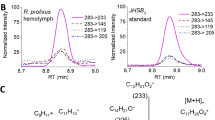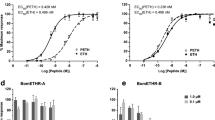Abstract
THE discovery of a binding protein, specific for juvenile hormone (JH)1 in the haemolymph of the tobacco hornworm, Manduca sexta, suggested that this protein carries JH molecules from the secretory organs (corpora allata) to the target sites. We report here that the binding protein provides the hormone total protection from degradative enzymes present in the haemolymph throughout early larval life2,3. Just before the start of pupal differentiation, however, a new esterase appears in the haemolymph which is able to hydrolyse the protein-bound hormone. We have also found that the binding protein at concentrations of 10−8 M strongly enhances the development-inhibiting action of JH on wing disk tissue in vitro. These properties, taken together, demonstrate a carrier role for the binding protein, and give new insights into the control of hormone levels in the haemolymph.
This is a preview of subscription content, access via your institution
Access options
Subscribe to this journal
Receive 51 print issues and online access
$199.00 per year
only $3.90 per issue
Buy this article
- Purchase on Springer Link
- Instant access to full article PDF
Prices may be subject to local taxes which are calculated during checkout
Similar content being viewed by others
References
Kramer, K. J., Sanburg, L. L., Kezdy, F. J., and Law, J. H., Proc. natn. Acad. Sci. U.S.A., 71, 493–497 (1974).
Slade, M., and Zibitt, C. H., in Insect juvenile hormones (edit. by Menn, J. J., and Beroza, M.), 155–176 (Academic Press, New York, 1972).
Weirich, G., Wren, J., and Siddall, J. B., Insect Biochem., 3, 397–407 (1973).
Oberlander, H., and Tomblin, C., Science, 177, 441–442 (1972).
Chihara, C. J., Petri, W. H., Fristrom, J. W., and King, D. S., J. Insect Physiol., 18, 1027–1248 (1972).
Whitmore, E., and Gilbert, L. I., J. Insect Physiol., 18, 1153–1167 (1972).
Emmerich, H., and Hartmann, R., J. Insect Physiol., 19, 1663–1675 (1973).
Jacobson, M., et al. in Insect Juvenile Hormones (edit. by Menn, J. J., and Beroza, M.), 249–302 (Academic Press, New York, 1972).
Ferkovich, S. M., Silhacek, D. L., and Rutter, R. R., Insect Biochem. (in the press).
Author information
Authors and Affiliations
Rights and permissions
About this article
Cite this article
SANBURG, L., KRAMER, K., KEZDY, F. et al. Role of juvenile hormone esterases and carrier proteins in insect development. Nature 253, 266–267 (1975). https://doi.org/10.1038/253266a0
Received:
Revised:
Issue Date:
DOI: https://doi.org/10.1038/253266a0
This article is cited by
-
Neofunctionalization of “Juvenile Hormone Esterase Duplication” in Drosophila as an odorant-degrading enzyme towards food odorants
Scientific Reports (2017)
-
Transcriptomes of parents identify parenting strategies and sexual conflict in a subsocial beetle
Nature Communications (2015)
-
10.1007/BF00191651
CrossRef Listing of Deleted DOIs (2011)
-
Juvenile hormone titre and regulation in the cockroachDiploptera punctata
Experientia (1985)
-
Genetics of esterases in Drosophila. VII. Genetic control of the activity level of juvenile hormone (JH)-esterase and heat resistance in D. virilis at high temperatures
Biochemical Genetics (1983)
Comments
By submitting a comment you agree to abide by our Terms and Community Guidelines. If you find something abusive or that does not comply with our terms or guidelines please flag it as inappropriate.



